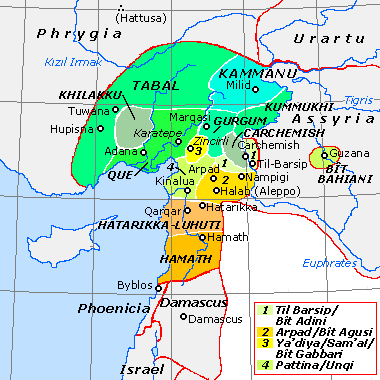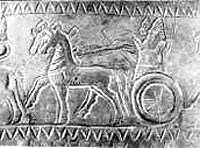|
Bit Agusi
Bit Agusi or Bit Agushi (also written Bet Agus) was an ancient Aramaean Syro-Hittite state, established by Gusi of Yakhan at the beginning of the 9th century BC. It had included the cities of Arpad, Nampigi (Nampigu) and later on Aleppo Arpad was the capital of the state-kingdom. Bit Agusi stretched from the A'zaz area in the north to Hamath in the south. Chronology According to Dan'el Kahn, there were seven stages of Bit Agusi history in Northern Syria in the ninth and eighth centuries BC. * Stage 1 (858–ca. 842 BC). Early on, Bit Agusi was apparently free of political alliances with neighbors. Arame, the second king of Bit Agusi, submitted to Assyria freely in 858 BCE, along with many other rulers of the region, including the southern Anatolia. * Stage 2 (841–823 BC). A period of Bit Agusi subjugation to Assyria. * Stage 3. Around 823 BC, or maybe a little later, Bit Agusi leads a local alliance opposing Assyrian hegemony, and achieves independence. * Stage 4. Also, soon ... [...More Info...] [...Related Items...] OR: [Wikipedia] [Google] [Baidu] |
Bit Adini
Bit Adini, a city or region of Syria, called sometimes ''Bit Adini'' in Assyrian sources, was an Aramaean state that existed as an independent kingdom during the 10th and 9th centuries BC, with its capital at Til Barsib (now Tell Ahmar). The city is considered one of the two chief states of the Aramean-held territories in the Euphrates along with Carchemish. It is considered an Early Iron Age Aramaean settlement between the Balikh and the Euphrates rivers, and extended westwards into northern Syria. Some sources also refer to it as a Neo-Hittite kingdom due to the discovery of Hittite hieroglyphic inscriptions. It is usually thought to have been in the bend of the Euphrates River, south of Carchemish. There are scholars who associate Bit Adini with Beth Eden, which may mean "house of evil" or "house of delight". History Bit Adini was ruled by a figure called Ahuni (also referred to as Akhuni) during the mid-ninth century BC and became part of a territory that included the Neo ... [...More Info...] [...Related Items...] OR: [Wikipedia] [Google] [Baidu] |
Atarshumki I
Atarshumki I (also ''Bar-Guš'') was the King of Bit Agusi in ancient Syria; he was the son of Arames. The capital of Bit Agusi was Arpad. History Like his father, Atarshumki was rebellious against the Assyrian supremacy. At that time, Assyria was ruled by Shamshi-Adad V and then by Adad-nirari III. Atarshumki tried to build a coalition with his neighbors against the Assyrians; finally, in 796, Adad-nirari III launched a military campaign in the area, and subjugated it. The territorial conflict between Hamath and Arpad The Antakya stele ( de) is believed to belong to the later years of Adad-Nirari III. This is when the prominent official Shamshi-ilu, who is involved with the inscription, became active. Based on this, the inscription is believed to date in the 780s BC. "The Antakya inscription describes the interference of the Assyrian King in a territorial conflict between Atarsumki, king of Arpad, and Zakkur, king of Hamath ... At that time, both kings were vassals of Adad-ni ... [...More Info...] [...Related Items...] OR: [Wikipedia] [Google] [Baidu] |
Gurgum
Gurgum was a Neo-Hittite state in Anatolia, known from the 10th to the 7th century BC. Its name is given as Gurgum in Assyrian sources, while its native name seems to have been Kurkuma for the reason that the capital of Gurgum—Marqas in Assyrian sources (today Maraş)—was named "the Kurkumaean city" (''ku''+''ra/i-ku-ma-wa/i-ni-i-sà''(URBS)) in local Hieroglyphic Luwian inscriptions. History The first historical event in the history of Gurgum is known for the reign of Larama I . This Gurgumaean king undertook a program of reconstruction including the replanting of crops and vineyards. In 858 BC, during the first western campaign of the Assyrian king Shalmaneser III, king Muwatalli II of Gurgum submitted to the Assyrians and paid them tribute. This tribute consisted of gold, silver, oxen, sheep, wine, and his own daughter with her dowry. Muwatalli II's son, King Halparuntiya II, undertook several military expeditions. He attacked the city (or land?) of Hirika (probably to ... [...More Info...] [...Related Items...] OR: [Wikipedia] [Google] [Baidu] |
Carchemish
Carchemish ( Turkish: ''Karkamış''; or ), also spelled Karkemish ( hit, ; Hieroglyphic Luwian: , /; Akkadian: ; Egyptian: ; Hebrew: ) was an important ancient capital in the northern part of the region of Syria. At times during its history the city was independent, but it was also part of the Mitanni, Hittite and Neo-Assyrian Empires. Today it is on the frontier between Turkey and Syria. It was the location of an important battle, about 605 BC, between the Babylonians and Egyptians, mentioned in the Bible (Jer. 46:2). Modern neighbouring cities are Karkamış in Turkey and Jarabulus in Syria (also Djerablus, Jerablus, Jarablos, Jarâblos); the original form of the modern toponym seems to have been Djerabis or Jerabis, likely derived from Europos, the ancient name of the Hellenistic-Roman settlement. Geography of the site Carchemish is now an extensive set of ruins (90 hectares, of which 55 lie in Turkey and 35 in Syria), located on the West bank of Euphrates Riv ... [...More Info...] [...Related Items...] OR: [Wikipedia] [Google] [Baidu] |
Quwê
Quwê – also spelled Que, Kue, Qeve, Coa, Kuê and Keveh – was a Syro-Hittite Assyrian vassal state or province at various times from the 9th century BC to shortly after the death of Ashurbanipal around 627 BC in the lowlands of eastern Cilicia, and the name of its capital city, tentatively identified with Adana, in modern Turkey. The name Que reflects the Assyrian transmission of the indigenous name Hiyawa, the same state is known as Hume from Babylonian sources. The question whether the toponym Hiyawa is related to Ahhiyawa, the Hittite designation of Mycenaean Greeks, is at present hotly debated. The principal argument in favour of a Greek migration into Cilicia at the end of the Bronze Age is the mention of Muksa/Mopsos as the founder of the local dynasty in indigenous Luwian and Phoenician inscriptions. According to many translations of the Bible, Quwê was the place from which King Solomon obtained horses. (I Kings 10: 28, 29; II Chron. 1:16) The species name ... [...More Info...] [...Related Items...] OR: [Wikipedia] [Google] [Baidu] |
Kummuh
Kummuh was an Iron Age Neo-Hittite kingdom located on the west bank of the Upper Euphrates within the eastern loop of the river between Melid and Carchemish. Assyrian sources refer to both the land and its capital city by the same name. The city is identified with the classical-period Samosata (modern-day Samsat Höyük), which has now been flooded under the waters of a newly built dam. Urartian sources refer to it as Kummaha. The name is also attested in at least one local royal inscription dating to the 8th century BCE. Other places that are mentioned in historical sources as lying within Kummuh are lands of Kištan and Halpi, and cities of Wita, Halpa, Parala, Sukiti and Sarita(?). Kummuh bordered the kingdoms of Melid to the north, Gurgum to the west and Carchemish to the south, while to the east it faced Assyria and later Urartu. Several indigenous rock inscriptions have been found in the region, all written in Hieroglyphic Luwian, attesting to the continuity of Hittite tr ... [...More Info...] [...Related Items...] OR: [Wikipedia] [Google] [Baidu] |
Samsat
Samsat ( ku, Samîsad), formerly Samosata ( grc, Σαμόσατα) is a small town in the Adıyaman Province of Turkey, situated on the upper Euphrates river. It is the seat of Samsat District.İlçe Belediyesi Turkey Civil Administration Departments Inventory. Retrieved 22 December 2022. The town is populated by . Halil Fırat from the (AKP) was elected mayor in the |
Sarduri II
Sarduri II (ruled: 764–735 BC) was a King of Urartu, succeeding his father Argishti I to the throne. The Urartian Kingdom was at its peak during his reign, campaigning successfully against several neighbouring powers, including Assyria. The succession from Sarduri II is not entirely clear. There's also attested a king Sarduri III, so Rusa may also have been his son. Sarduri II notably expanded Urartian territory by conquering the northern region of Colchis, as well as Melid and Kummuh in the Euphrates valley. In 743 BC, at a battle located somewhere in Kummuh, the Assyrians, under Tiglath-pileser III, defeated Sarduri and his anti-Assyrian coalition, forcing the Urartians back across the Euphrates. Sarduri II was so confident in his power that he erected a massive wall at Tushpa (modern-day Van) with the following inscription: :"the magnificent king, the mighty king, king of the universe, king of the land of Nairi, a king having none equal to him, a shepherd to be wondered ... [...More Info...] [...Related Items...] OR: [Wikipedia] [Google] [Baidu] |
Tiglath-Pileser III
Tiglath-Pileser III (Neo-Assyrian cuneiform: , meaning "my trust belongs to the son of Ešarra"), was the king of the Neo-Assyrian Empire from 745 BC to his death in 727. One of the most prominent and historically significant Assyrian kings, Tiglath-Pileser ended a period of Assyrian stagnation, introduced numerous political and military reforms and more than doubled the lands under Assyrian control. Because of the massive expansion and centralization of Assyrian territory and establishment of a standing army, some researchers consider Tiglath-Pileser's reign to mark the true transition of Assyria into an empire. The reforms and methods of control introduced under Tiglath-Pileser laid the groundwork for policies enacted not only by later Assyrian kings but also by later empires for millennia after his death. The circumstances of Tiglath-Pileser's rise to the throne are not clear. Because ancient Assyrian sources give conflicting accounts concerning Tiglath-Pileser's lineage and t ... [...More Info...] [...Related Items...] OR: [Wikipedia] [Google] [Baidu] |
Neo-Assyrian
The Neo-Assyrian Empire was the fourth and penultimate stage of ancient Assyrian history and the final and greatest phase of Assyria as an independent state. Beginning with the accession of Adad-nirari II in 911 BC, the Neo-Assyrian Empire grew to dominate the ancient Near East throughout much of the 8th and 7th centuries BC, becoming the largest empire in history up to that point. Because of its geopolitical dominance and ideology based in world domination, the Neo-Assyrian Empire is by many researchers regarded to have been the first world empire in history. At its height, the empire was the strongest military power in the world and ruled over all of Mesopotamia, the Levant and Egypt, as well as portions of Anatolia, Arabia and modern-day Iran and Armenia. The early Neo-Assyrian kings were chiefly concerned with restoring Assyrian control over much of northern Mesopotamia and Syria, since significant portions of the preceding Middle Assyrian Empire had been lost during a long p ... [...More Info...] [...Related Items...] OR: [Wikipedia] [Google] [Baidu] |


